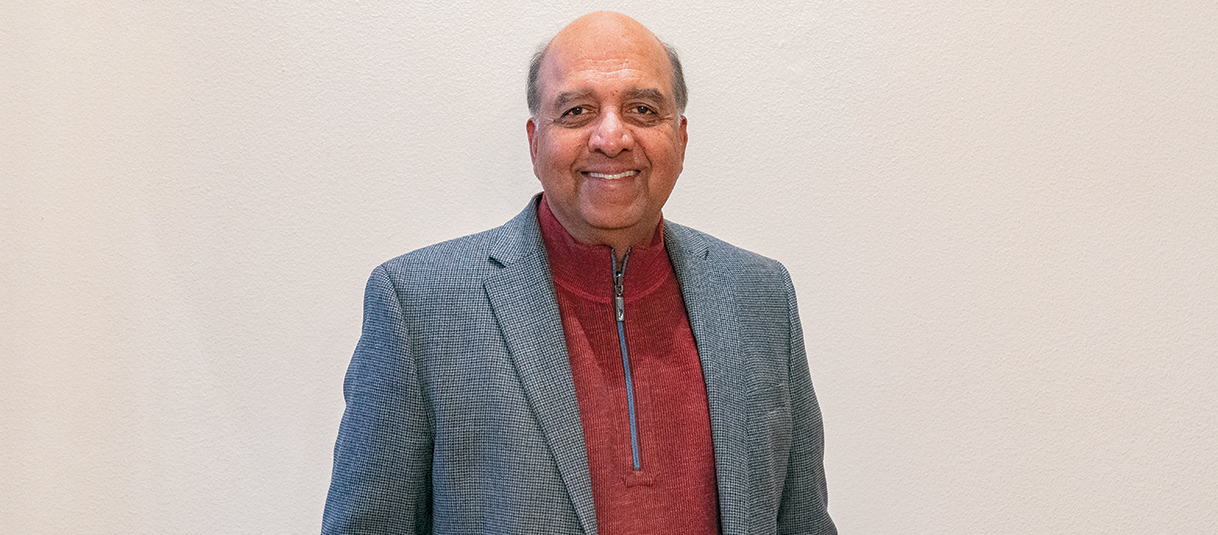BY EMILY AYSHFORD // view article PDF
When Edgar Menezes (MS ’79, PhD ’80) enrolled in Northwestern Engineering to pursue a doctoral degree in materials science in the late 1970s, many people didn’t understand what being a materials scientist meant.
Truth be told, Menezes himself didn’t fully understand polymer rheology—essentially the deformation and flow of plastics—when he arrived at the McCormick School of Engineering from India. He had studied chemical engineering at the Indian Institute of Technology Madras and had chosen Northwestern’s materials science program because of its top reputation. He liked the idea of blending that training with physics to study new materials.
It turned out to be the right move. Forty years after getting his degree, Menezes can look back at a long career at Johnson & Johnson where he worked with many kinds of plastics: textiles, surgical sutures, contact lenses, and eyeglasses. Across a wide range of health and medical applications, he became a prolific inventor and now has more than 60 patents to his name.
“I’m proud that I could contribute as an inventor, in research and development, and at the management level,” he says. “I was able to balance all that at so many levels and accomplish what I wanted to accomplish.”
Learning How to Understand New Fields
Menezes’s first memory of arriving in Chicago was the cold—the lowest temperature he had experienced before was 60 degrees, and he had never seen snow. “The first winter was a rude shock,” he laughs. Northwestern placed him with a host family for his first month, which helped him ease into the new culture.
He spent the next several years conducting his research in the lab at night and sleeping during the day, allowing him more access to lab equipment and helping him avoid distractions. He picked up new ideas as he needed them from different fields. These experiences proved to be key throughout his career. His first job at Monsanto Company was in the textile fiber division, where, despite having no experience in the industry, he quickly developed new processes for spinning polymer fibers.
A year later, Menezes joined Johnson & Johnson, where he would work for the next 30 years. He started off working with surgical sutures. “I had to quickly learn about the medical field—what’s important to the surgeons, their patients, and hospitals—to develop products that were optimal for all,” he says. “Drawing on my experience in graduate school, I found I could quickly pick up the science and technology and grasp ideas at the forefront of different fields.”
From Scientist to Inventor
More than that, Menezes had breakthrough ideas for new products or new ways to design products. Johnson & Johnson encouraged these ideas, and Menezes found himself working after hours on designs that the company would ultimately patent. In addition to the sutures, he designed other surgical products before developing new kinds of contact lenses and eyeglasses. Several commercial products emerged from his patents.
Menezes credits his time at Northwestern with helping him learn not only how to conduct research, but also how to think creatively and keep working at a problem until he found a solution. That, he says, is how he became such a successful intrapreneur.
“The products I helped develop were within the mission of the company, so they had no problem investing in the patents— filing them and defending them in court,” Menezes says. “To see products launched based on those patents, products that ultimately helped customers, was pretty satisfying.”
Encouraging the Next Generation of Materials Scientists
Menezes ended his career as the company’s director of intellectual property. By that time, he had so much experience dealing with IP that he became the translator between the scientific staff and the lawyers.
Though he retired in 2011, he still finds time to do some consulting work while pursuing his other interests in golf, photography, and travel. He and his wife have visited more than 60 countries. They also spend time at Northwestern with the goal of getting more undergraduates interested in pursuing advanced study in materials science and have made philanthropic gifts to support undergrad-uate research and the new Materials Science Teaching Lab in Cook Hall.
“Students are not always exposed to the research process as undergraduates,” he says. “I want to help give them an opportunity to understand what research is like, so maybe they will think it’s a good path to follow. Materials science is a great field to pursue. Materials are often the limiting factor in our ability to create new things, new technologies. Knowing what materials can or cannot do is the difference between success and failure.”

